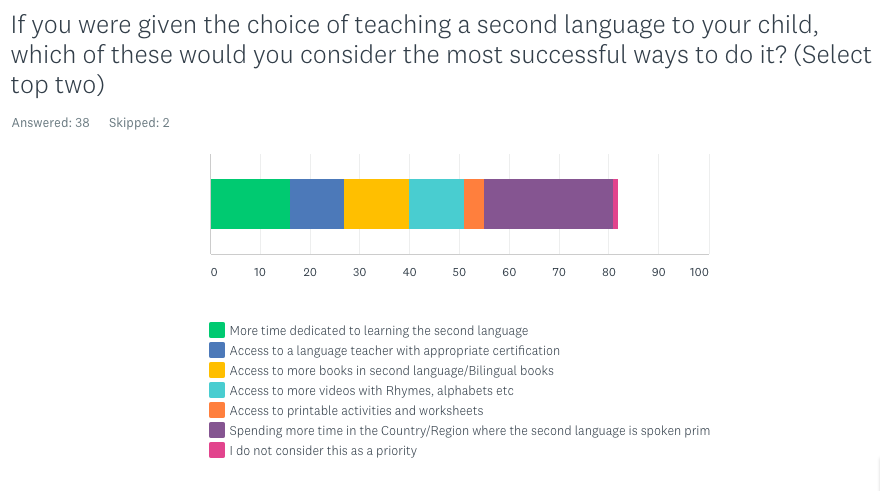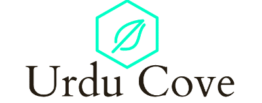Read this in:
 اردو (Urdu)
اردو (Urdu)
Recently there has been a lot of commotion about Urdu as our native language. Language and identity go hand in hand. I remembered I had conducted a survey of bilingual parents at the beginning of my blogging journey. One response particularly echoed some similar concerns. I thought this would be a great time to discuss that.
I did this survey out of pure curiosity to find out what bilingual parents in my circle thought. As humans, we are naturally curious about what others are thinking about a particular subject (hello social media).
So I conducted this survey to get an objective point of view of people in my circle who happened to be bilingual parents living in a non-native environment. i.e. They speak Urdu at home whereas the environment is predominantly English.
I will share the data in image form and then share my thoughts.
1. Number of languages spoken

My pool was small and most of the responders spoke three languages! I would consider myself to be in the same category.
I wrote about the multilingual culture that I come from in a previous post. Click to read.
2. Languages spoken by responders(besides English)

I tried to include as many languages as I could.
Since my community has mostly people from a similar background as me, Urdu was the second most popular language (almost 54%) followed by Spanish (almost 31%) and then Punjabi (at almost 26%). French and Hindi tied after that at 7.7%.
3. Attempts at teaching their child

An overwhelming majority from the group had tried teaching a second language to their child.
4. Resources to use for teaching a second language

This was a very interesting response.
Most responders (almost 82%) found family interaction to be the most helpful.
This was followed by storybooks (almost 60%) and then videos on platforms such as Youtube.(almost 41%)
Of note, using language apps and language tutors who were outside the family were found useful in only 25% of responses combined.
This makes complete sense.
Learning language is like doing push-ups
Language is a muscle you develop by using it as frequently as you can.
Disuse atrophy is a medical term that describes the phenomenon that if you don’t use it, you lose it. This is easy to see in people who have strokes or another disease which leads to muscles all shrinking up since they are not being used.
This can be compared to the apps or tutor classes. Language cannot be learning by scheduling it in only small sessions. That limits the repeated use needed to reinforce the brain muscle paths. That is exactly how disuse atrophy happens.
Reading together (post here) has the same principle. You are providing the kids the chance to flex their brain muscles. They will beef it up every time you make them use their second language skills.
5. Best way to teach a second language

This was a hypothetical question I posed to see what the responders thought.
Most of them (about 68%) chose the option to spend more time in the native country of the second language.
This is called immersion and it is a proven method to learn a second language.
So much so that in this study they tested learning of an artificial language in two groups using classroom versus immersion. After the sessions, they were tested 5 months later to assess how much they remembered and how well.
Those exposed to the immersion method had a more native-like response even when they were not exposed to the made-up language outside the sessions.
This is fascinating to me. It means that your brain remembers the language better if you learn it in a native environment.
Time spent learning the language was another one.
I have a guest post that talked about how long it takes to learn a second language (French in this case) and how being bilingual can speed that up.
Normally it depends on what kind of language you are trying to learn.
Now consider this image showing the information about how many weeks on average it takes for an English native speaker to learn a language from each category. (link to this fascinating data right here)

I will consider Urdu as my language of choice.
What blows my mind is that Arabic, yes ARABIC that we insist on teaching our kids so they can read the Quran, is considered category 5. Urdu is actually easier than that at category 4.
That means it would take around 44 weeks for English speakers to learn Urdu and 88 weeks to learn Arabic!
So there you have it! We have a much better chance of teaching our kids Urdu than we think.

As you can see, almost 46% of my responders admitted that they did not know what is the upper limit of age to learn a language. Almost 22% thought the window of language learnig closes at 6 years of age. The lowest number was those who thought 18 years old is the highest age for learnign a new language.
I will link the post here about myths of bilingualism, in which I specifically answer this in great detail.
To be honest, there is a difference between learning a language and learning it with a native level proficiency.
So while developing native-like proficiency happens when you are exposed to the language as early as possible (under 10 if possible), there is no upper limit of age to learn a new language.
Now the comment that really echoed some of my concerns
I am going to put the comment here. I do not know who made it but the point is, to be honest about Urdu as a second language and how we feel about doing that.
I feel like teaching a second language like urdu, which is my mother tongue (sic) is not necessary if we are living abroad because they will never be able to relate to it like we did. They will never use it to interact and will not be interested in learning the true heritage of it. The only advantage is they will be able to interact with their grandparents, which is a huge advantage , when grandparents cannot understand English. Even if I teach them urdu, it will die out with her generation and they will never pass it on to their kids. I am all for teaching them a second language but it doesnt have to be my mother tongue…
-survey responder
I want to know how you feel about this.
Personally, I can tell you that we as native speakers of our mother tongue (Urdu) already have the tools we need to teach our language to the kids. We are our children’s best chance to teach our mother tongue.
I hope that this way, they can be inspired to create literature, books, poems, and everything else that is needed to help Urdu evolve.
We as bilingual parents have already so much on our plate that teaching a language simply seems like too much. But I have done this and can tell you with certainty, that it is possible.
Please share this post, and let me know your thoughts.
Read this in:
 اردو (Urdu)
اردو (Urdu)


Excellent survey. I agree with comment by a survey responder but I am in strong favor of learning different languages. Of course number of languages learnt varies with individual’s capability
Thank you for the feedback! I think I am more optimistic…or at least I hope that Urdu can evolve regardless of the challenges it faces… being bilingual does give us a huge advantage when it comes to learning a new language though!
Great survey. In my opinion If we will not speak Urdu with children then how are they going to learn it and if we just start thinking that we shouldn’t teach them as this will die in near future then of course it will die if we will not try to pass it on to them 🙂
Urdu is such a beautiful language ❤️ We should keep it alive. It also helps in learning Arabic language which is the language children learn to understand Quran 🙂